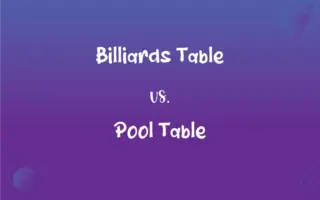Adjacent vs. Adjoining: What's the Difference?
Edited by Aimie Carlson || By Janet White || Published on January 30, 2024
Adjacent refers to lying near or close to but not necessarily touching. Adjoining refers to touching or contiguous to.

Key Differences
Adjacent refers to something being next to or near another object, with an emphasis on proximity rather than physical contact. Adjoining, however, implies that two objects are not only near each other but also share a common boundary or are touching.
In usage, adjacent can describe areas, buildings, or objects that are close to each other but not necessarily connected. For example, two houses can be adjacent without sharing a wall. Adjoining rooms or buildings, in contrast, are connected directly, like hotel rooms with a common door.
When describing spatial relationships, adjacent suggests closeness but allows for some separation or intervening space. Adjoining conveys a stronger sense of connection, often indicating that there is no physical barrier between the two entities.
Adjacent is often used in broader contexts, such as in geography or planning, to describe the relative positions of objects or areas. Adjoining, on the other hand, is typically used in more specific contexts where direct contact or connection is a key aspect.
In terms of usage flexibility, adjacent can be used metaphorically to describe ideas or concepts that are related but not necessarily directly connected. Adjoining is less likely to be used in a metaphorical sense, as it implies a direct and physical connection.
ADVERTISEMENT
Comparison Chart
Connection
Close proximity, no physical contact
Direct physical contact or connection
Usage Context
Broader, can be metaphorical
Specific, usually physical structures
Spatial Relationship
Nearness without touching
Touching or sharing a boundary
Example
Two adjacent streets
Adjoining hotel rooms
Flexibility
More flexible, can describe non-physical concepts
Less flexible, typically physical
ADVERTISEMENT
Adjacent and Adjoining Definitions
Adjacent
Next to or adjoining something.
Our garden is adjacent to the park.
Adjoining
Joined to or connected with.
The adjoining rooms shared a common wall.
Adjacent
Immediately preceding or following.
In the alphabet, B is adjacent to A.
Adjoining
Directly connected or in contact.
The two adjoining pieces of the puzzle fit perfectly.
Adjacent
Close to but not necessarily in contact with.
The two buildings are adjacent but separate.
Adjoining
Next to and joined with.
They booked adjoining seats at the theater.
Adjacent
Situated near or close by.
The adjacent room was quiet.
Adjoining
Touching or contiguous.
The garage is adjoining the house.
Adjacent
Lying near or close to.
The coffee shop is adjacent to the library.
Adjoining
Sharing a common boundary.
Their garden is adjoining ours.
Adjacent
Close to; lying near
Adjacent cities.
Adjoining
Neighboring; contiguous.
Adjacent
Next to; adjoining
Adjacent garden plots.
Adjoining
Being in contact at some point or line; joining to
An adjoining room
Adjoining
Present participle of adjoin
Adjoining
Joining to; contiguous; adjacent; as, an adjoining room.
Upon the hills adjoining to the city.
Adjoining
Having a common boundary or edge; touching;
Abutting lots
Adjoining rooms
Rhode Island has two bordering states; Massachusetts and Conncecticut
The side of Germany conterminous with France
Utah and the contiguous state of Idaho
Neighboring cities
FAQs
Can two countries be adjacent?
Yes, if they are near each other without a shared border.
Can adjacent be used in a metaphorical sense?
Yes, it can describe non-physical concepts that are related.
Can adjacent areas share a border?
Not necessarily; adjacent implies closeness without direct contact.
Can adjacent be used for ideas?
Yes, it can describe ideas that are closely related.
Can adjacent imply a degree of separation?
Yes, adjacent allows for some intervening space.
Do adjoining rooms always have a door between them?
Often, but not always; the key aspect is the shared boundary.
Is adjoining limited to physical structures?
Generally, yes, as it implies physical connection.
Do adjoining rooms share the same wall?
Typically, yes, they share a wall or boundary.
Does adjoining imply direct contact?
Yes, it involves touching or sharing a common boundary.
Are adjoining properties more closely connected than adjacent ones?
Yes, adjoining implies a higher degree of connection.
Do adjoining items need to be similar?
Not necessarily, but they must be physically connected.
Is adjacent more versatile in usage than adjoining?
Yes, due to its broader application beyond physical connection.
Are adjoining rooms considered one unit?
They can be, especially in hotels or apartments.
Can adjoining imply cohesiveness?
Yes, due to the direct connection or touch.
Are adjoining areas always accessible from one another?
Generally, but there can be exceptions depending on the context.
Can two plots of land be adjoining?
Yes, if they share a common boundary.
Does adjacent always mean right next to?
Not always, it implies nearness but allows for some distance.
Can adjacent be used for time sequences?
Yes, for events or periods close to each other in time.
Is adjacent suitable for describing spatial relationships?
Yes, particularly in geography or urban planning.
Is adjacent used in mathematics?
Yes, in geometry for describing nearby angles or sides.
About Author
Written by
Janet WhiteJanet White has been an esteemed writer and blogger for Difference Wiki. Holding a Master's degree in Science and Medical Journalism from the prestigious Boston University, she has consistently demonstrated her expertise and passion for her field. When she's not immersed in her work, Janet relishes her time exercising, delving into a good book, and cherishing moments with friends and family.
Edited by
Aimie CarlsonAimie Carlson, holding a master's degree in English literature, is a fervent English language enthusiast. She lends her writing talents to Difference Wiki, a prominent website that specializes in comparisons, offering readers insightful analyses that both captivate and inform.







































































